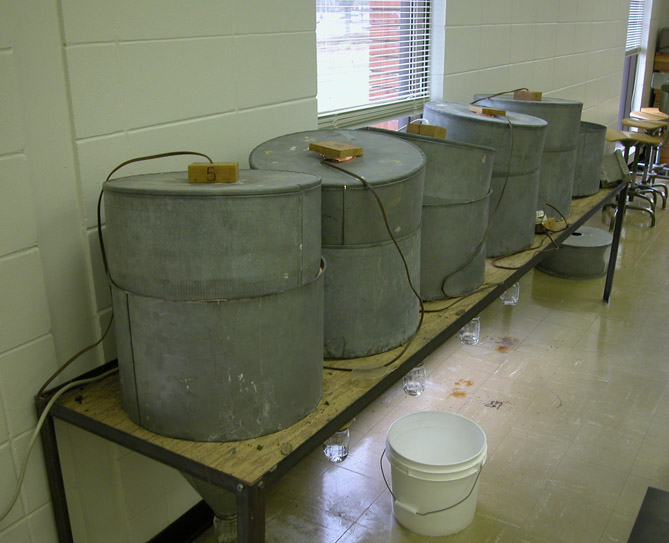Berlese FunnelsAuthor: Joe A. MacGown |
Berlese funnels are used for extracting arthropods from soil and litter samples. They work on the principle that insects and other arthropods that normally live in soil and litter will respond negatively to light. Therefore, a light source is used to force the arthropods to move downward, where they will fall into a funnel and then into a container of ethanol. Soil and litter samples are first collected in a natural habitat, usually in a forested area. The samples may be sifted first so as to maximize the amount collected (for more information on sifting). There are many variations of Berlese funnels, but basically you nee a bucket of some type, a cover for the bucket, a large funnel that fits down inside, wire mesh screen, a jar or some type of container with ethanol in it, and a light source. The funnels pictured below were specially made by a local metal shop and are larger than those that can be purchased. These work well for large samples of soil/litter, especially if they is a lot of leaves or other woody material present. We use 40 watt light bulbs for these. The screen is placed at the bottom of the cylinder and just about the welded funnel below the main cylinder. The litter and soil mix is place on the screen, the jar of ethanol is screwed on at the bottom of the funnel, then the top of the cylinder is put on, and the light is turned on. It is important to have some sort of pan under the funnel before putting your sample in and before the jar of ethanol is screwed, because some soil and litter will fall through the screen. This material can usually be placed back on the screen and most of it will remain in place the second time around, at which point the jar can be placed under the funnel. We usually let these large Berlese funnels run for 5 days or so. Smaller Berlese funnels are made from 3 to 5 gallon buckets, with the funnel being placed inside of the bucket, a small screen placed down in the funnel, a jar of ethanol placed underneath the funnel, and a metal cover for the bucket with a light affixed to the inside of it. Because the light is much closer to the litter than in our larger funnels, we only use a 25 watt light bulb for these traps. However, due to the smaller size of these funnels, the soil samples dry out much faster, usually within 2 days. The smaller funnels hold much less soil/litter sample as well. There is some question about whether the smaller funnels dry the arthropods out before they can move. For samples we run for ants, we use 90 to 95% ethanol. An alternative to the Berlese funnel is a Winkler sack. The winkler sack is usually made of fabric and can be folded to take up little space when not in use. Winkler sacks can be taken into the field and do not need a powered light source. Even without the light source, the arthropods still move downward through the sample where they eventually fall into a container (usually a whirlpack) of ethanol. |
 |
Six large Berlese funnels set up. Notice the mason jar with ethanol underneath the funnels. |
|


